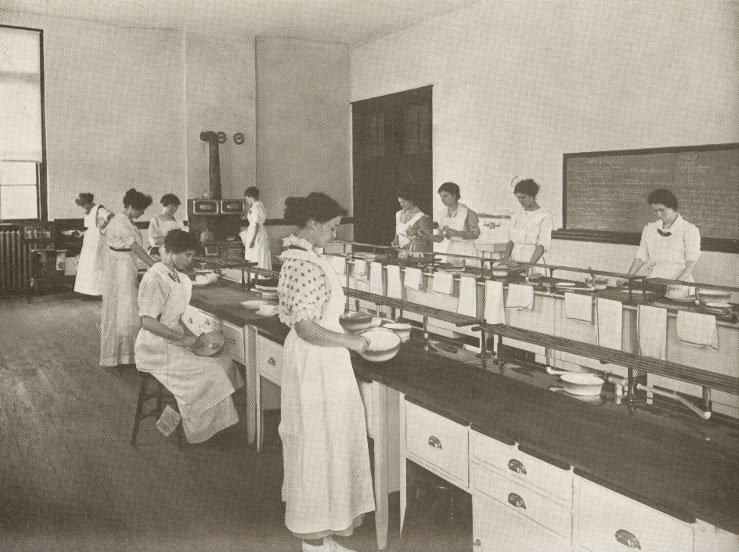In the early twentieth century, “household economics,” “domestic science,” and “euthenics” were innovative yet controversial fields of study. Doubting that the State Normal School in Greensboro needed such a curriculum, one skeptic argued that “a trained mind can manipulate a vacuum cleaner or teach a servant to keep the kitchen sink clean or even work-out a well-balanced dietary for the family without having had a domestic science course in college.” Advocates responded that “’a trained mind’ needed to be trained in school.” As a progressive school, ECTTS never questioned the importance of these areas of study, early on associating them with the study of science as a core dimension of teacher education. At the same time, East Carolina’s domestic science curriculum, Jim Crow by charter, contributed indirectly to the creation of modern white identity and heightened arrogance about white supremacy.
In East Carolina’s first year, there was no training facility for domestic science. By the third year, however, the school catalog boasted of a “domestic cabin,” also known as the “domestic science cabin,” “demonstration cabin,” and affectionately as the “Little Red Cabin.” The cabin was nothing more than “a small house on the school property” that had been “converted into a domestic science laboratory,” supposedly “providing an attractive class kitchen and a dining room where the art of properly cooking and serving food … [was] taught.” It was here that students early on learned the principles of “home economics,” i.e., “those factors that make for a more sanitary and a more hygienic mode of living and that influence the physical, mental, moral, and aesthetic nature of man.”
Beginning with Jennie Ogden, a charter faculty member, ECTTS had an instructor in household economics. Early on, these instructors worked with the school cafeteria to ensure that “the daily menu” was consistent with “scientific principles” and of “great educational value to the students.” Elizabeth Pugh, a graduate of a domestic science school, the Stout Institute, followed Ogden. In her second year, Pugh also worked in cooperation with the new matron of the Dining Hall, Mary Rankin, in planning menus. In 1914-1915, Martha Armstrong, trained at Teachers College, Columbia University, became the new instructor of “domestic science.” The same year, Nannie F. Jeter, a trained dietician, took charge of the cafeteria as its new matron. The turnover in positions related to domestic science surely reflected high demand in that field early on.
By 1914, the new domestic science laboratory, prominently located on the second floor of the new wing of the Administration Building and … “modern in every respect,” had been added, indicating East Carolina’s strong commitment to domestic science. Because half of the courses in the domestic science curriculum related to cooking, the new laboratory soon came to be known simply as the cooking laboratory. By 1918-1919, reflecting its growing significance, “Home Economics” was listed as an independent program of study, with multiple courses in cooking, sewing, and dressmaking. Yet as taught and practiced during Jim Crow times, domestic science and home economics were nuanced in terms of white supremacy, with the knowledge gained through their study counting not so much toward better health for everyone as a stronger, healthier white race. At ECTTS, where the faculty and students were, by charter, white, domestic science, although a progressive discipline at a progressive school, was grounded in assumptions and practices nuanced in terms of white supremacy.
Sources
- Armstrong, Martha. “Household Arts in Rural Schools.” Training School Quarterly. Vol. 1, no. 2. July, August, September, 1914. Pp. 92-94.
- “As the Women See It: Canning Demonstration at E.C.T.T.S. Monday afternoon.” Greenville News. July 14, 1917. P. 4.
- Cooley, Angela Jill. To Live and Dine in Dixie: The Evolution of Urban Food Culture in the Jim Crow South. Athens: University of Georgia, 2015.
- “Domestic Science in Colleges.” Everything (Greensboro). May 30, 1914. P. 7.
- “Domestic Science Cabin.” Fifth Annual Catalogue of the East Carolina Teachers Training School, 1913-1914. Raleigh: Edwards & Broughton Printing Co., 1914.
- “East Carolina Teachers Training School Notes.” News and Observer. January 25, 1910. P. 5.
- “Science.” Sixth Annual Catalogue of the East Carolina Teachers Training School, 1913-1914. Raleigh: Edwards & Broughton Printing Company, 1914.
- “The new domestic science laboratory.” University Archives # 50.03.1.13. J. Y. Joyner Library. East Carolina University. Greenville, N.C. https://digital.lib.ecu.edu/11486. Picture from Training School Quarterly. Vol. 1, no. 3. October, November, December, 1914. Frontispiece.
Citation Information
Title: Domestic Science Lab
Author: John A. Tucker, PhD
Date of Publication: 6/7/2018
